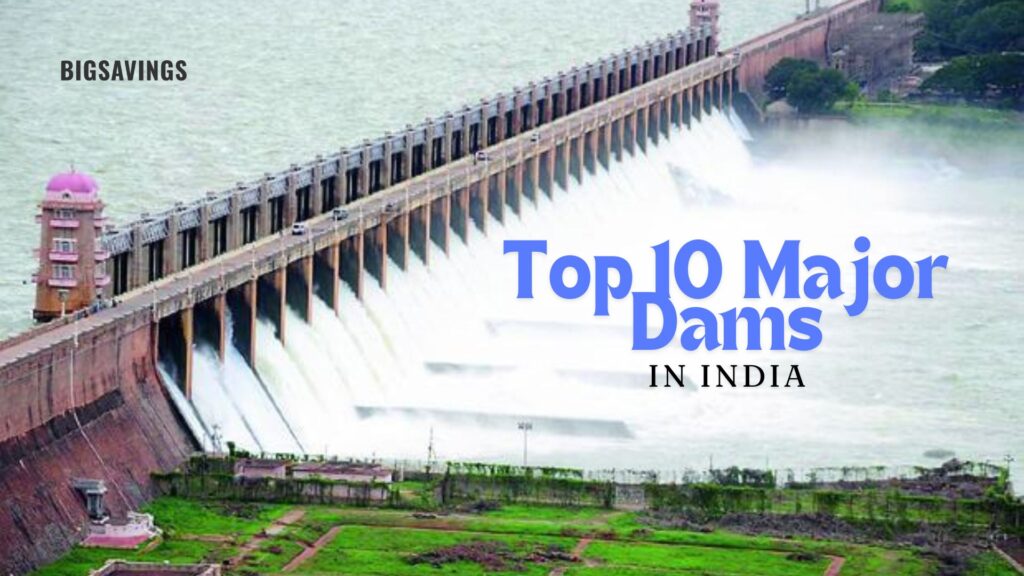
Top 10 Major Dams in India
Top 10 Major Dams in India: As of 2024, India boasts an impressive 5,334 dams, a testament to the country’s ongoing efforts to preserve water resources and utilize them for various purposes, including electricity generation and irrigation. While some of these dams are still under construction, they will soon be operational, adding to the vast infrastructure that plays a crucial role in meeting India’s growing needs. Today, we’ll take a closer look at the top 10 major dams that stand out in this expansive list. So, if you’re curious to find out which dams make the cut, let’s dive in. Top 10 Major Dams in India
- Tehri Dam
Tehri Dam, located in Uttarakhand, is India’s tallest dam, standing at an impressive 260.5 meters. This earth and rock-fill embankment dam, built between 1978 and 2006, sits on the Bhagirathi River, part of the Ganges River system. Tehri Dam plays a crucial role in hydroelectric power generation, irrigation, and supplying drinking water to cities. Its vast reservoir holds approximately 3,540 million cubic meters (Mm³), ensuring a steady flow of water and supporting multiple regions. - Chamera Dam
Nestled in the Chamba district of Himachal Pradesh near Dalhousie, Chamera Dam is a towering structure completed in 1994. Built on the River Ravi, it rises 226 meters high and has a power generation capacity of 540 megawatts. Beyond power, Chamera Dam has become a popular tourist spot, thanks to the picturesque Chamera Lake, where water sports are a hit. With a reservoir capacity of 3,913 million cubic meters, this dam contributes significantly to the local economy. Top 10 Major Dams in India - Bhakra Dam
One of India’s most iconic dams, Bhakra Dam is located on the Sutlej River in Himachal Pradesh. Completed in 1963, it stands 226 meters high and forms the Gobind Sagar Reservoir, one of India’s largest artificial lakes, holding 9.34 billion cubic meters of water. Bhakra Dam supplies irrigation, drinking water, and electricity to several states, including Punjab, Haryana, and Rajasthan, making it a vital infrastructure project in India’s post-independence era. - Lakhwar Dam
Currently under construction, the Lakhwar Dam is set to be a key player in water management for Uttarakhand, Uttar Pradesh, and Haryana. Once completed, this dam on the Yamuna River will stand 204 meters tall and help generate electricity while providing essential water for irrigation. The reservoir, with a capacity of 58 Mm³, will support agricultural needs and water management for the region, especially during dry spells. Top 10 Major Dams in India - Idukki Arch Dam
Idukki Arch Dam in Kerala is one of Asia’s tallest arch dams, standing at 168.91 meters. Completed in 1975, it blocks the Periyar River to create a reservoir covering 60 square kilometers with a capacity of 1.996 cubic kilometers (km³). The dam supports a nearby hydroelectric power station with a capacity of 780 megawatts. Idukki Arch Dam is not only a marvel of engineering but also a significant contributor to Kerala’s power supply. - Pakal Dul Dam
Pakal Dul Dam, located in Kishtwar, Jammu and Kashmir, is another dam under construction, slated for completion soon. Once finished, it will stand 167 meters tall and generate 1,000 megawatts of electricity. Built on the Marusudar River, a tributary of the Chenab River, Pakal Dul Dam will increase the region’s power generation capabilities. The project includes a 10-kilometer-long tunnel that will transport water to a nearby power station, adding to its significance. - Sardar Sarovar Dam
The Sardar Sarovar Dam, part of a large-scale project on the Narmada River in Gujarat, is a vital structure that supports agriculture and electricity generation across four Indian states. With a height of 163 meters and a length of 1,210 meters, the dam’s reservoir holds 0.95 million hectare meters of water. Officially inaugurated in 2017 by Prime Minister Narendra Modi, the dam is integral to water management and energy production in the region. Top 10 Major Dams in India - Ranjit Sagar Dam
Ranjit Sagar Dam, also known as Thein Dam, straddles the Ravi River near Punjab and Jammu & Kashmir. Completed in 2001 after two decades of construction, the dam is 160 meters tall and stretches 617 meters in length. It plays a significant role in the region’s water supply, electricity generation (600 megawatts), and irrigation. With a reservoir capacity of 1.25 billion cubic meters, it’s a critical resource for the surrounding states. - Srisailam Dam
Situated on the Krishna River between Andhra Pradesh and Telangana, the Srisailam Dam is one of India’s largest, standing at 145 meters tall and 512 meters long. Completed in 1981, it supports power generation (1,670 megawatts) and irrigation. Its massive reservoir, holding 178.74 Tmcft of freshwater, provides water for agriculture and drinking purposes, making it a cornerstone of water management in southern India. - Baglihar Dam
Baglihar Dam, located on the Chenab River in Jammu and Kashmir, rises 143 meters high and has a reservoir capacity of 475 million cubic meters. Completed in two stages by 2016, it was designed to enhance the region’s electricity supply with a total output of 900 megawatts. The dam’s construction sparked international controversy, particularly with Pakistan, which argued that its design violated a water-sharing treaty. Top 10 Major Dams in India
Conclusion
India’s top 10 dams showcase the country’s dedication to water conservation, energy production, and sustainable development. As new dams continue to be constructed, the future looks promising for India’s ability to manage its water resources and meet its growing energy needs. Keep an eye on future developments, as these impressive structures are sure to continue shaping India’s infrastructure landscape. Top 10 Major Dams in India





More Stories
which of the following statements is true about education and lifetime earnings? Complete Guide Here
Statekaidz.com: Education with Fun For Kids 2025
Top 5 Richest States in India by GDP